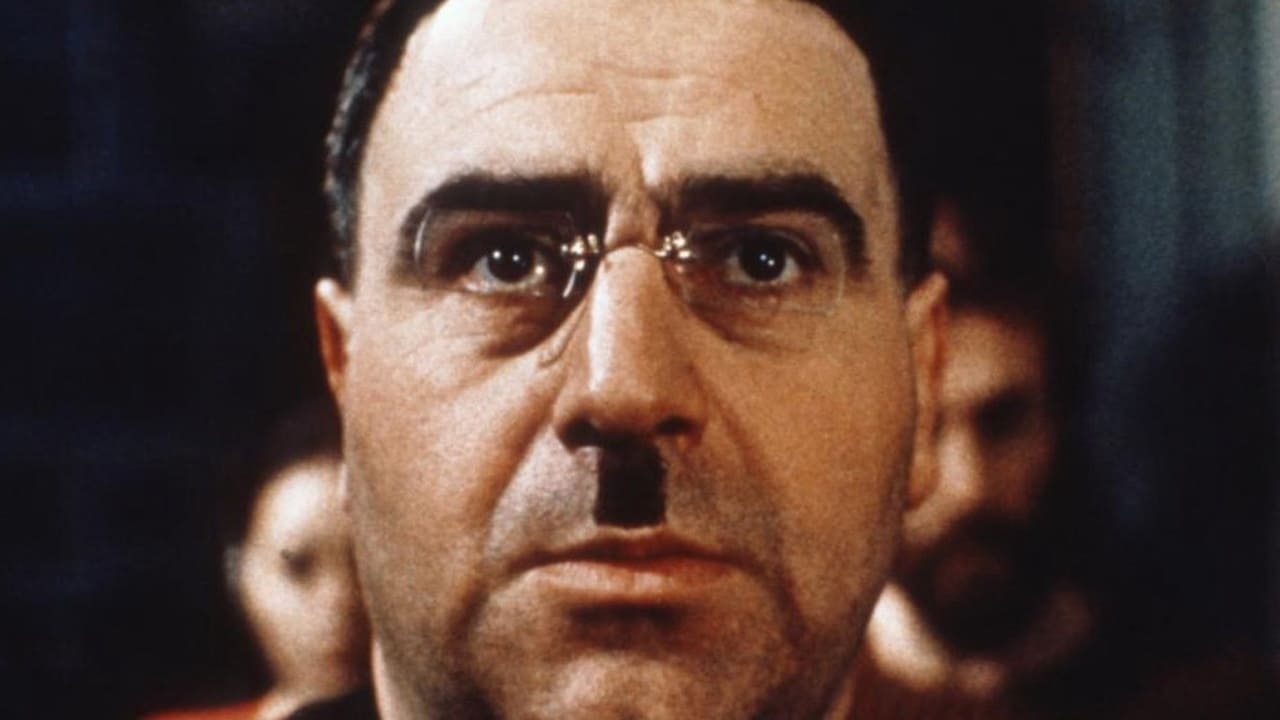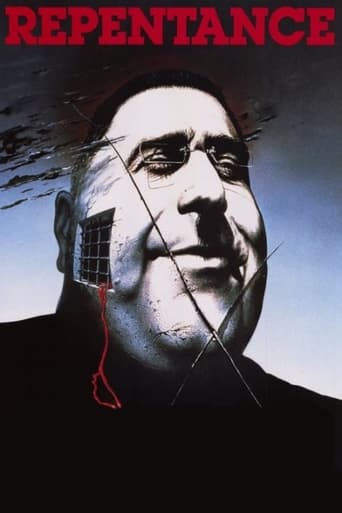



Fantastic!
Simple and well acted, it has tension enough to knot the stomach.
View MoreThere are moments that feel comical, some horrific, and some downright inspiring but the tonal shifts hardly matter as the end results come to a film that's perfect for this time.
View MoreExactly the movie you think it is, but not the movie you want it to be.
View MoreRepentance is a film one would expect to come out of Perestroika and Glasnost. It is a Stalinist/early Soviet metaphor that would have never been seen before this time. The story begins in present day, or in this case 1984. In a small Georgian town, the mayor, Varlam Aravidze, dies. The seemingly important citizens of the community come to pay their condolences at his funeral. However, one day after the funeral, the corpse is found at the home of the mayor's son. The corpse is reburied . . . but is removed from the crypt a second and third time. A woman is taken into custody and put on trial. She admits to having done it; much of this part of the film is full of flashbacks focusing on Varlam's terrible reign, revealing her motives for having done it. Varlam looks like a combination of dictators. There are traces of Hitler (the mustache) and Mussolini (the black shirt), but of course he can also be compared to Stalin and Beria, two of the cruelest names known in Soviet history, both who were of Georgian origin. Varlam was the Stalinist figure, and the two other generations of his family could be considered a lot of the rest of Soviet history. His grandson clearly represents the period of Glasnost and Perestroika. He has trouble accepting what his family has done, and he commits suicide because of it (I'm sure it was not meant to be this way, but it could be considered a foreshadowing of the end of the Soviet Union). The son of Varlam is sort of everything in between Stalin and Perestroika (except the anti-Stalin Krushchev years).This was a very interesting movie; it was a little too full of symbolism, but beautifully made. It was a very interesting change watching a Georgian Soviet film instead of a Russian made Soviet film.
View MoreAfter the death of Stalin, folks in the Soviet Union were allowed to express their feelings towards his reign of terror...at least to a point. However, the government also was concerned that these complaints might lead to complaints about the current system--and this is probably why "Repentance" was banned for several years after it was filmed. It does attack the Stalinist era and mentality--but apparently those in power at the time weren't willing to allow such a film to be released."Repentance" is a very surreal sort of film--one which has many story elements that seem dreamy and unreal while the rest of it is quite literal. While there were purges, seeing the 20th century purges carried out by knights in armor, a living statue of Justice and many other story elements are dream-like and strange. This is not really a complaint--just an observation. The film looks almost like Dalí or Buñuel added a few touches here and there...just a few.The story begins in the present day. The beloved mayor of a Georgian town, Varlem, has died and folks come to his funeral to pay their respects. However, several times after the funeral, the body of this man has been taken from the crypt and placed in his yard! After the third time, they catch the woman responsible and she is taken into custody. At the hearing, she openly admits having done it and tells a story of long ago--when Varlem first became mayor. At that time, he made a name for himself persecuting the innocent--and the story is about how this impacted the woman personally.Following her long tale, the story goes to the present day. The hypocrisy and evil of Valem's friends are examined as well--including one case about a man who struggles between Atheism and Christianity. Under Christianity, he SHOULD feel guilt--and he ultimately gets to meet the Devil (this is pretty weird...and clever). Other folks all begin to confront their own part in Varlem's reign of terror.Instead of this film directly attacking Stalinism, it clearly attacks these tactics on a smaller scale. And, I am sure it was not unintentional that Varlem looked much like a bloated Hitler! A very strange but daring film. While today it might be seen as very tame, back in the mid-1980s it must have caused the filmmakers a lot of problems--and potentially prison. Quite clever but quite slow and strange. Well worth seeing--especially if you lived through this era.
View MoreThe movie starts with a newspaper obituary recording the death of Varlam Aravidze, the mayor of a town in Georgia. We're then shown what has happened in the town in the past when Varlam was mayor. He's nominally a communist type, however it's made pretty clear that his stripes, and the stripes of all Stalinists, are feudal. This is shown, for example, by having the police of the town dressed as mediaeval knights. It's an idea explored in Iosseliani's Brigands too, that Russian rulers have been a succession of crazed autocratic knaves. At one point in the film Varlam plaintively quotes from Shakespeare's sonnet 66: Tired with all these, for restful death I cry, As, to behold desert a beggar born, And needy nothing trimm'd in jollity, And purest faith unhappily forsworn, And gilded honour shamefully misplaced, And maiden virtue rudely strumpeted, And right perfection wrongfully disgraced, And strength by limping sway disabled, And art made tongue-tied by authority, And folly doctor-like controlling skill, And simple truth miscall'd simplicity, And captive good attending captain ill: Tired with all these, from these would I be gone, Save that, to die, I leave my love alone. Which is a harangue against everything he stands for. He's a man who has knowingly chosen to do wrong, a comedian who has turned his fiefdom into a comedy of terror. At one point he arranges for his son to jump out of a second story window to shock his captive audience, but in fact the boy is caught below. He surrounds himself with illiterate sycophants whom he brings into and out of favour arbitrarily, arranges for people to be arrested and benevolently releases them when complaints are made. In the end however he's merely a snake playing with its live food before devouring. Varlam arranges for people to be exiled, presumably to Siberia although we're not told. One day a shipment of logs arrives on the outskirts of town. They have been logged by the kidnapped men of the town. Each survivor has carved their name into the end of the timber. Women from the town trudge around the muddy lumberyard looking for their husbands' names, looking for proof of life for men denied the right of correspondence. This is the most powerful scene in my opinion. There are also a number of dream scenes and very surreal scenes that are very appealing in their artistry, which I leave the reader to discover for themselves. Varlam is, as has been pointed out, a concoction of dictators (superficially containing elements of Hitler, Mussolini, and Stalin), but may well, in more concrete terms be based on a real life figure, Georgian-born Lavrentiy Beria, a man more unpleasant than the imaginations of most can conjure up. He was Stalin's chief murderer, a sexual sadist who performed unimaginable feats of depravity, he also briefly participated in the running of Russia as part of a "troika" after Stalin's death. The film does not dwell on the huge depths of his depravities, as the acts he performed are unspeakable and unfilmable. The film is a quiet but firm indictment however of Stalinist politics, of the manipulation and double-think and an ode to Georgian culture. The purpose of the film is to not let Beria, or more generally the authoritarians of the time, rest in peace; to act as testament to the cruel depravities of the Stalinist era. In my opinion it's absolutely unmissable.
View MoreI have to say that my review is based on what I saw in 1990. I was 21....................................The plot is your standard totalitarian nightmare. Let's dispense with it.Everything else is uniquely boring: the symbolism, the surrealism, the open politics and the veiled, the acting, the dialogue, the pace.Worse, most of it, one or two cinematically breathtaking sequences aside, is unoriginal.Some would probably require you to sit through this, for the sheer culture of it all.But in the end, why bother.Because the ones done away by the tyrants have little use for surreal, artistic pastiches.
View More